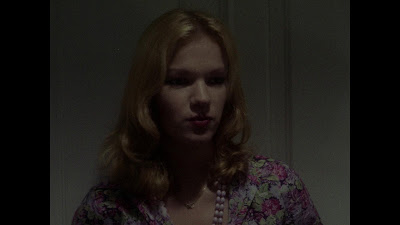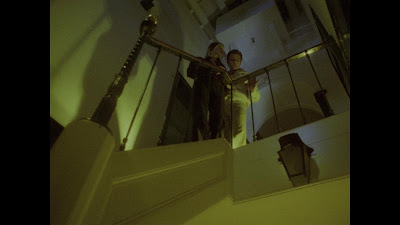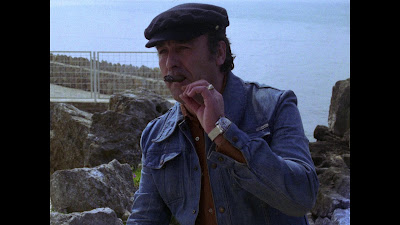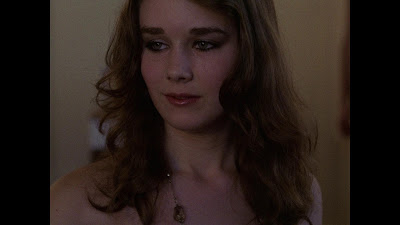As an ambitious theatre actor, present director Marco Antonio Andolfi had previously appeared in a few downscale Italian films including Luigi Russo’s and Enzo Doria’s rather baffling Adam & Eve story BLUE PARADISE (1983). With THE CROSS OF THE 7 JEWELS (1987) however, his first—and only—directorial effort, he not only directs, but also acts, writes, edits, and even handles the special effects! Difficult to classify, let alone understand, Andolfi’s wannabe werewolf picture is wildly overplotted and completely inept, which no doubt helped earn the film its deserved obscurity. That said, you still have to admire Andolfi’s enthusiasm (or just marvel at his perceived self-importance!), a fact which Italy’s Tetrovideo happily praises with their recent eye-catching, extras-filled Blu-ray.

Hidden away in a dingy basement, a satanic mass is underway, which is presided over by a chanting high priest (Gordon Mitchell), as he and his oversexed followers attempt to resurrect Aborym. Having seen one of his disciples unexpectedly transform into a hulking, shaggy-haired monster (who we assume must be the worshipped Aborym), the always-charismatic Mitchell begins to overact wildly. “Aborym! We are your slaves!” he cries. “Show yourself to me!” Abruptly and inexplicably, the film shifts to Naples where Marco Sartori (director Andolfi hiding behind his Eddy Endolf alias) has just arrived from Rome and meets with his cousin Carmela. As they stroll through the sunny city streets making small talk, a pair of scippatori (purse-snatching thieves) steal a special jeweled cross from around his neck. Determined to track down this vitally important piece of jewelry, Marco befriends Maria (Annie Belle) at a chintzy nightclub, and with her help, they scour the Naples underworld in search of his precious pendant, even rubbing shoulders with high-ranking Camorra bosses and Sicilian Mafiosi (one of whom is played by former leading man, Giorgio Ardisson), which allows Andolfi to introduce several unnecessary plot threads, most of which rapidly go nowhere.

During the film’s first reveal of the so-called werewolf, director Andolfi confirms your conviction at the absurdity of what is unfolding before your very eyes. When Marco questions a lowlife, ornery fence about the whereabouts of his jeweled cross, he is quickly dismissed (“Calm down or you’ll give me a heart attack!”), but as the clock strikes midnight, Marco changes into something not entirely human, which consists of an overstuffed furry pelt on his head, hairy mitts with claw-like fingernails, some conveniently placed ‘fur’ covering his crotch, and nothing more. As Marco proceeds to foolishly grin and grind his teeth at the camera, he telekinetically (!?) melts the fence’s face into a big pile of goop, which makes for a fun and cheap effect, even if it is just a wax head being liquefied by an out-of-frame blowtorch.

Although what it lacks in sophistication, Andolfi’s film more than makes up for in demented gusto, which also includes several poorly choreographed punch-ups with local Camorra thugs, corrupt politicians, and plenty of low-level criminality, which makes it come across like some sort of ersatz crime actioner masquerading as a horror film. In one prolonged scene, which includes a laughably out-of-date—and painfully slow—transformation scene wherein he only grows a few months’ worth of facial hair, he proceeds to wipe out an entire syndicate (“No need for an ambulance. They are all dead!” Mutters one commissario as he fatalistically shrugs his shoulders). In his haste to pursue all possible leads in the search for his cross, our decidedly unconventional hero eventually finds himself back in Rome where he visits Madame Armesia (Italian porn starlet Zaira Zoccheddu), a flamboyant fortune teller, which not only precipitates the film’s sleaziest scene, but also a rather head-scratching, anticlimactic confrontation.

Adding to the film’s elusive nature, THE CROSS OF THE 7 JEWELS never saw a home video release in North America or even Italy for that matter. Andolfi’s film first appeared on Japanese VHS videocassette in 1987 courtesy of Sony Video Software, and even though it was in English and nicely letterboxed (with burned-in Japanese subtitles, of course), it also suffered from the usual digital censorship, which awkwardly obscured all below the waist nudity. Outside of the grey market, this once highly-collectible VHS tape pretty much remained the only legitimate release of the film until Tetrovideo’s 2022 Blu-ray. Featuring an all-new 4K scan taken from the film’s original camera negative, this is a massive improvement over its VHS counterparts, and while the image does appear to have a certain softness at times (a product of the original haphazard photography), it still manages to include an ample amount of finer detail with true colours and nice depth. The LPCM 2.0 Italian audio track does what it can with the source material, but it isn’t overly dynamic, and of course, the post-sync dubbing is still very noticeable. Optional English subtitles are also included, which are well-timed and fairly well-translated, save for the occasional grammatical error. Unfortunately, the film’s hilarious English audio track, which features prolific voice talent artists such as Ted Rusoff, Robert Sommer and Pat Starke, is strangely absent, so keep that Japanese tape if you own it! For those viewers that need it, optional French and German subtitles are also included. An audio commentary with filmmakers Luca Ruocco and Ivan Talarico is also offered for those viewers that can understand Italian.

Not to worry though, there are still plenty of English-friendly special features (all of which are in SD) contained on the disc beginning with Luca Ruocco’s Riassumendo Marco Antonio Andolfi (trans: Summing up Marco Antonio Andolfi, 19m18s), which gives a thorough overview of Andolfi’s humble beginnings assembling his theatre company Artisti Riuniti, his migration into securing some bit parts (and missed opportunities) in films, and eventually helming his vanity project (and its subsequent iterations), which dominated the rest of his spotty career. Next up, we get Ruocco’s short film JEKYLL/HIDE (2005, 23m53s), which includes a brief ’30s-style horror intro from Andolfi, but seeing as it’s only in Italian, most English viewers will undoubtedly just skim through it. Having established a working relationship with Ruocco, Andolfi decided to helm RIECCO ABORYM (2008, 29m42s), a VERY belated sequel of sorts to TCOT7J, which has an ageing Marco (referred to here as “Eddy”) recollecting his troubled past to his girlfriend (Margherita Di Sarno) after a clumsily executed bout of lovemaking. Even with English subtitles, interminable scenes of actors doing or saying practically nothing – even when they are saying something – fill the running time, during which Andolfi pads the film out with reconstituted scenes from TCOT7J, which only serves to further elaborate his continued narcissism and make this nigh on unwatchable. A brief making-of documentary entitled Riecco Aborym: il backstage (14m33s) is also included, and is actually more interesting than the film itself. An Italian language “Super VHS version” (80m15s) of TCOT7J also turns up, which seems wholly unnecessary, but it’s here just the same for those that enjoy such things.

In 1995, Andolfi released TALISMAN (87m27s), a substantially re-edited and re-scored edition of TCOT7J, which now opens in 1962 and talks of a “precious talisman that radiated well-being”, which was stolen from the “heart of Africa”, and then brought about “world famines, war and disaster.” Lazily expanded with newsreels and documentary footage as well as a few stolen scenes from Hollywood blockbusters, Andolfi further tweaks this new edition with some bizarre—and completely useless—video effects to try and give everything a grander, more up-to-date scale. Despite its disjointed and excessively reworked narrative, which makes for a confusing time, it’s an interesting inclusion just the same, if not merely for the fact of seeing how to further cheapen (i.e., ruin) an already cheap and trashy film!

Other extras include a brief deleted scene (1m31s), part of which originally served as a sepia-toned nightmare sequence that ran for 4m10s in the aforementioned English-language export version released in Japan, and which isn’t included in any of the versions on this disc. The extensive extras conclude with two different trailers for TCOT7J (1m04s and 1m27s), an overly-long TALISMAN (6m08s) trailer, and a trio of photo galleries. Incidentally, in a rather sloppy bit of disc authoring, all of the extras play out in one continuous file, but can, at the very least, be accessed separately by returning to the special features menu. The Limited Edition Mediabook, which included a 20-page booklet and an oversized slipcover reproducing the Japanese vidart has since sold out, but the standard edition (which includes all the same extras) is still available from either Tetrovideo or DiabolikDVD.
Even if THE CROSS OF THE 7 JEWELS has the dubious arguable distinction of being one of the poorest Italian horror films ever made, there is no denying Tetrovideo’s excellent restoration and handsomely packaged Blu-ray, which should please most fans of grade-Z Italian cinema.






































